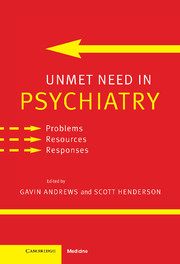Book contents
- Frontmatter
- Contents
- List of Contributors
- Preface
- Part I Unmet need: defining the problem
- Part II Unmet need: general problems and solutions
- Part III Unmet need: people with specific disorders
- Introduction
- 13 The unmet needs of people suffering from schizophrenia
- 14 The early course of schizophrenia: new concepts for early intervention
- 15 Unmet need in depression: varying perspectives on need
- 16 Unmet need following serious suicide attempt: follow-up of 302 individuals for 30 months
- 17 Met and unmet need for interventions in community cases with anxiety disorders
- 18 The unmet need for treatment in panic disorder and social phobia
- 19 Alcohol-use disorders: who should be treated and how?
- 20 Putting epidemiology and public health in needs assessment: drug dependence and beyond
- 21 Why are somatoform disorders so poorly recognized and treated?
- Part IV Unmet need: specific issues
- Part V Unmet need: conclusion
- Index
17 - Met and unmet need for interventions in community cases with anxiety disorders
from Part III - Unmet need: people with specific disorders
Published online by Cambridge University Press: 21 August 2009
- Frontmatter
- Contents
- List of Contributors
- Preface
- Part I Unmet need: defining the problem
- Part II Unmet need: general problems and solutions
- Part III Unmet need: people with specific disorders
- Introduction
- 13 The unmet needs of people suffering from schizophrenia
- 14 The early course of schizophrenia: new concepts for early intervention
- 15 Unmet need in depression: varying perspectives on need
- 16 Unmet need following serious suicide attempt: follow-up of 302 individuals for 30 months
- 17 Met and unmet need for interventions in community cases with anxiety disorders
- 18 The unmet need for treatment in panic disorder and social phobia
- 19 Alcohol-use disorders: who should be treated and how?
- 20 Putting epidemiology and public health in needs assessment: drug dependence and beyond
- 21 Why are somatoform disorders so poorly recognized and treated?
- Part IV Unmet need: specific issues
- Part V Unmet need: conclusion
- Index
Summary
Requirements for population-based needs assessment in anxiety disorders
The basic prerequisites for a population-based evaluation of need for anxiety disorder treatment in developed health care systems are: (1) clearly specified disorders and/or related disabilities for which (2) effective and (3) acceptable interventions/treatments are available and (4) can be provided (Häfner, 1979; Wittchen, 1988).
It is generally agreed that these basic requirements are widely met for most forms of anxiety disorder. First, explicit diagnostic criteria, operationalized diagnoses [DSM-III, American Psychiatric Association (APA), 1980; DSM-IV, APA, 1994; and ICD-10, World Health Organization (WHO), 1993] and diagnostic instruments [i.e., the Composite International Diagnostic Interview (CIDI, WHO, 1990)] allow mental health specialists and primary care doctors to recognize and diagnose most forms of anxiety disorder reliably (Wittchen, 1994).
The improved diagnostic techniques have led to better identification of the risk factors for first developing anxiety disorders, secondary psychosocial disability, and psychopathological complications (Kessler et al., 1994; Magee, Eaton, Wittchen, McGonagle & Kessler, 1996; Wittchen et al., 1995 a,b,c). They have also allowed characterization of the disorder's natural course, which is usually persistent (Wittchen, 1991). Rice & Miller (1998) demonstrate the impact that anxiety disorders have on society, by revealing that more is spent, in direct and indirect costs, on anxiety disorders than on depressive or psychotic disorders.
Second, there are various highly effective pharmacological and psychological treatments for anxiety disorders, and their disadvantages and limitations have been described (Andrews, Crino, Hunt, Lampe & Page, 1994; Bond & Lader, 1996; Elkin, Pilkonis, Docherty & Sotsky, 1988; Fineberg & Drummond, 1995).
Keywords
- Type
- Chapter
- Information
- Unmet Need in PsychiatryProblems, Resources, Responses, pp. 256 - 276Publisher: Cambridge University PressPrint publication year: 2000
- 8
- Cited by



